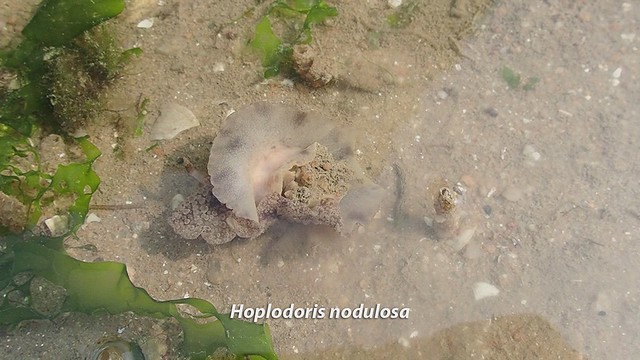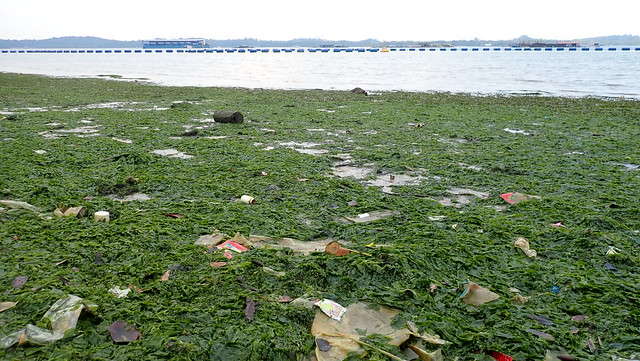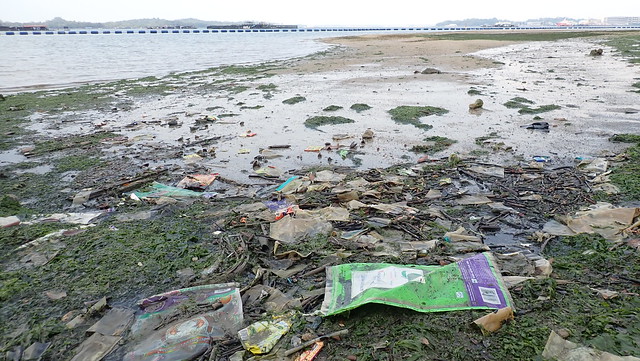A small team surveys another part of Pasir Ris Park shores. We are delighted to see fresh lush seagrasses, rocks dotted with sponges and thus nudibranchs!
We also saw many large sea stars! Even well loved and easily accessed shores are very much alive.
There were lots of very large Eight-armed luidia sand stars on the shore, each bigger than my foot. I also saw one small bright orange Cake sea star and some small Plain sand stars came out as it got dark. But I didn't see any Biscuit stars.
Here's a video of some of the Eight-armed luidia sand stars. These predatory sea stars are active and do look scary. Their presence suggest that there is lots of their prey to feed on. That's probably a good sign.
Small rocks dot the shores and there were many sponges growing on them. The most abundant were Smooth rainbow sponges that came in many bright colours.
Sponges are the favourite food of nudibranchs, so it was not too surprising to see this nudibranch. I first saw its egg ribbons before I spotted it, well camouflaged against the encrusted rocks.
Healthy patches of Zebra coral covered many of the rocks, there was also one small colony of Skinny sea fan. I saw two Ribbon jellyfishes washed up the shore, our first record for this shore. There were also some large and generally healthy looking Haddon's carpet anemones, although one was rather pale. I didn't come across any other sea anemones or other cnidarians. Seems I saw a wider variety on my last survey in Jul 2019.
Other creatures seen include many Stone crabs hiding in crevices and lots of Orange striped hermit crabs out and about on the seagrass meadows. I saw some small young Window pane shells but no Fan clam shells or other scary invasive mussels. I saw a few small Thorny sea cucumbers and Pink warty sea cucumbers.
Many Orange fiddler crabs have settled on a sand bank. This male is busy trying to shove a female into his burrow!
There was also a Hairy sea hare. These slugs squirt out purple ink when they are alarmed. I saw more of these sea hares on my last survey here in Jul 2019.
I saw many egg capsules of the Spiral melongena snail, when I came across one mama snail laying some. I didn't see any Gong gong snails or other large snails. The last time I surveyed this shore in Jul 2019, there were many Babylon snails. Today, I didn't see any.
Many parts of the shore were densely covered in Straw tubeworms.
Lush growths of Spoon seagrass still cover most of the intertidal. The shoreline is quite firm and sandy in some parts. But is still very soft and silty in most parts. I didn't see any dugong feeding trails today. The last time I saw them here was on our survey in Jul 2017.
There was a bloom of Sea lettuce (Ulva) on some parts of the shore.
I saw two people collecting on the shore, carrying two heavy looking plastic bags of their finds. I couldn't catch up to them to chat with them to find out more.
The shore is still trashy. I still came across many bags of rice, sugar, flour, as well as of carbohydrates like bread, instant noodles, cookies. There are about 60 Singapore fish farms located off Pasir Ris. They probably use these kinds of ingredients to make food for the fish they raise. The farms are not provided with door-to-door trash collection and are expected to bring their trash back to the mainland for proper disposal.
Let's hope these amazing shores remain healthy until our next survey.
Photos by others on this trip
Kelvin Yong
Richard Kuah















